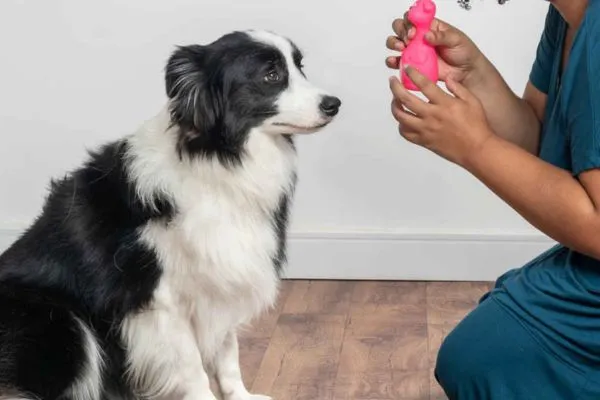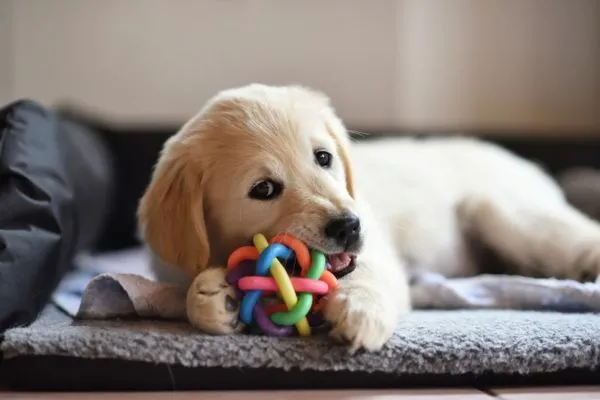Every pet parent’s worst nightmare is that your dog has eaten a rubber toy. While rubber toys are non-toxic, they can obstruct your dog’s digestive system, leading to serious health problems if not treated quickly. So what do you do? Let’s look at what to do if dog eats rubber toy.
If your dog eats a rubber toy, monitor for signs of distress, consult a vet, and consider safer toy options to prevent future incidents.
Symptoms of Eating Rubber Toys
If your dog has eaten a rubber toy, the first thing to do is assess the situation and look for any signs that he or she may be uncomfortable.
The most common symptoms include vomiting, abdominal pain, loss of appetite, lethargy, and sudden changes in behavior. If your pup exhibits these symptoms, it’s time to take them to the vet immediately.
Also Read: How To Get Rid Of Dog Poop Smell In House?
Treatment Options for Eating Rubber Toys

Eating rubber toys is a common problem for many pet owners. The most effective treatment option for this issue is first to get it diagnosed by a veterinarian. Your vet may recommend X-rays, blood work, or other tests to determine the cause of your dog’s behavior and what treatment plan they should follow.
If there are no underlying health issues, the best approach is to set up a routine that removes access to rubber toys as much as possible and directs the unwanted behavior elsewhere more appropriately. For example, providing your pup with plenty of mental stimulation can be an amazing way to keep them busy and out of trouble!
Allowing your extra pup time outside in a safe yard will enable them to burn off some steam while also providing more supervised activities and areas where they can safely explore their environment – eliminating any risk of leaving rubber toys lying around the house where they could easily be chewed on!
It’s important to remember that puppies go through a phase of mouthing objects, so make sure you monitor your pup closely during this developmental period when chewing habits start forming.
You can also use positive reinforcement methods such as rewards-based training and physical manipulation like redirecting their attention towards chewable objects approved by you – i.e., chew sticks, ropes made specifically for dogs, etc., all excellent solutions!
Last but certainly not least, products designed specifically for reducing destructive behaviors in dogs (such as bitter sprays) may help discourage rubber toy munching. However, these aren’t always long-term solutions but rather temporary deterrents from harmful chewing habits – proper training is key here!
Also Read: Do Dogs Get Cold In The House?
What To Do If Dog Eats Rubber Toy?
Preventing your dog from eating rubber toys can be a daunting task. The main challenge is that even if you remove the rubber toy, it’s likely that your pup will find a way to get another and start nibbling away again.
But with some patience and perseverance, you can break this habit before it causes any serious harm to them. Here are some basic tips that should help you:
1) Provide alternative chew toys– If other chew toys are in the house, then your pup won’t have access to the rubber ones. Look for durable chew toys made of rope or hard rawhides which your dog will enjoy just as much – they won’t be able to resist!
2) Make sure all chewing objects in the house are out of reach – No matter how close you watch your pup, there might be certain moments when they snatch something off an easily accessible spot or table. Place these objects on high shelves or cupboards where they can’t reach them, so there’s no temptation!
3) Reinforce good behavior with rewards – Use treats or praise as motivation for staying away from unwanted items like rubber toys. Whenever they obey and follow commands while keeping their attention away from forbidden objects, reward them with verbal praises and positive reinforcement techniques such as clicker training so they become aware of what behavior is right and wrong about their desires for chewing items around the house.
4) Take time during playtime – Create opportunities every day when both of you can spend quality time together playing fetch games, which provide mental stimulation and physical exercise that’ll keep him/her preoccupied instead of thinking about munching on rubber items!
5) Avoid leaving them alone too long – Boredom is a major source behind dogs’ tendency towards eating anything, including rubbers; if possible, try not to leave him alone without supervision (or even better, take him along!). Busy streets do not make an ideal environment when trying to control his behaviors so stay vigilant at all times by spending more quality time with him whenever available
6) Consult veterinarians whenever needed – If nothing seems to be working out, don’t hesitate to consult veterinarians who’ll advise on the best possible solutions specific to breeds & ages accordingly & outline expected outcomes based upon previous treatments elsewhere within similar scenarios, always being proactive is highly advisable!.
Also read: Why Use A Car Seat Hammock For Dogs?
Bottom Line:
What to do if dog eats rubber toy? If your dog eats a rubber toy, it can result in serious health complications that require expensive veterinary intervention—so it’s best to take preventive measures whenever possible. Ensure all chewable items are put away when not being used.
Switch out traditional rubber toys for softer materials such as cotton or wool, which won’t be so hard on their teeth if swallowed accidentally. With proper precautions taken, pet parents can avoid this unfortunate scenario altogether!

